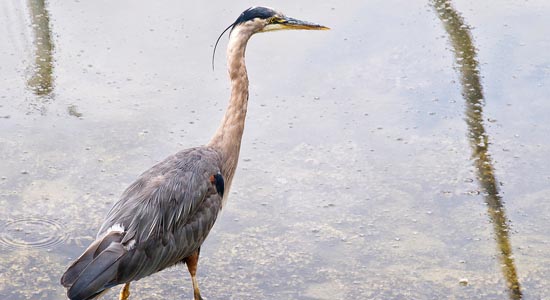Last week Sunday morning an attack was made on our home garden pond. The perpetrator is so far fugitive, however, “footprints” could be secured.
The stolen goods: several fish. The villain: a heron . The remaining fish must now be quickly brought to safety! What is allowed in the protection from herons.
A heron, also known as a gray heron, visited our garden pond unnoticed and ate several fish. Among them was unfortunately our pond mother, a white, about 30 cm long female goldfish, which gave us much joy for several years.
Besides the goldfish mother, several shubunkis (further development of goldfish with a blue color in them) had to believe in their lives. Since herons are under nature protection, they cannot be killed easily. Therefore, some cunning is needed to ensure protection from herons at the garden pond.
7 tips for protection from herons
- To repel herons, for example, a heron repellent can be used. This is a combination of garden hose and motion detector. As soon as a heron is approaching, water bubbles out of the hose. This should scare off the heron for the time being.
- A variant of this is the acoustic heron protection. Instead of the bubbling water, a signal tone appears when movement is detected.
- All objects that shine or reflect light distract the heron. Since herons prefer an undisturbed hunting ground, they should also be deterred by such a measure.
- For example, a shiny foil that floats on the garden pond in the form of a floating pyramid can help here. A reflective floating ball is commercially available, so in this case a floating heron deterrent. Likewise, there are mirrored spinning tops for hanging.
- The heron should not have a landing opportunity at the edge of the garden pond. Herons prefer to land directly in shallow water or on the edge of the pond. Place large, round stones around their water area or place garden sculptures and flower pots. Not quite as handsome, but just as effective, is a 60 cm high wire fence around the pond.
- In addition to measures directly around the pond, you can also disturb the landing approach, as the heron needs a relatively large amount of space to do so. A bird net or a leaf protection as pond cover irritates him. With this method, however, care should be taken that no smaller birds or even the heron itself get caught in the bird net. If this is the case, the bird net must be removed again.
- Another method of repelling herons is to cover the garden pond with thin floral wire or fishing line, which also glistens in the sun. In this case, the wires should be stretched in one direction at a distance of about 30 cm and once at right angles to it (distance about 50 cm). The wires, roughly stretched crosswise, severely restrict the freedom of movement of a heron, so in the best case it will look for another fish pond. The disadvantage of this method, however, is that you are hindered by the tensioned wires during pond maintenance.
- Relatively simple is the installation of a fish heron dummy. It is assumed that herons do not hunt at ponds of other herons. The dummy – a pond figure – signals to the real heron that the pond is already occupied. Unfortunately, this method did not work for our garden pond 🙁.


